Meat Trade Journal
London butcher The Ginger Pig is to start selling charcoal alongside its meat.
The premium charcoal, called Chef’s Blend, is to be supplied exclusively to the butcher’s shop by The London Log Company, and will be available from 26 June in the Ginger Pig’s shops in Clapham, Shepherd’s Bush, Hackney, Marylebone and Barnes.

According to its makers, Chef’s Blend is a mix of beech, birch, oak and ash with a little English fruitwood, which create aromatic flavours that work especially well with dry aged grass and beef fed lamb, but are subtle enough to use with all meats.
Mark Parr of the London Log Co was excited about the partnership: “The Ginger Pig are as obsessed about beast, taste and welfare, as I am about wood, fire and flavour, so a collaboration was as easy as falling off a log, so to speak. We share a common passion for food and its provenance; a mutual respect for the land where we grow our produce, the people involved and the joy that the end product engenders. To be able to work in your chosen field (or woodland) and strive to produce excellence is a gift. To share your work and have that recognised by others, is even better.”
Foodservice companies looking to gain customers’ trust should use more British meat and making customers aware of it, according to the National Pig Association (NPA).

Nearly 70% of shoppers trust the meat they buy in supermarkets either a lot or a fair amount, compared to only 58% of those who said they trusted the meat they are served in restaurants and just 17% in fast food restaurants, according to a recent YouGov survey.
The NPA pointed to Sainsbury’s as a good example of a company that has seen its business boosted by the implementation of a policy of only using British pork, ham and sausages. It has since rolled this out to include its sandwiches and in-store cafes, resulting in a 10% upturn in this part of the business.
We know sourcing more British meat and promoting the fact on-pack to customers means supermarkets have stolen a huge lead on restaurants and fast-food chains when it comes to gaining public trust,’ said NPA chairman Richard Lister.
“If foodservice companies want the public to trust them to a similar degree, the answer is staring them in the face. They should copy Sainsbury’s by serving British pork and pork products, and advertising the fact widely.
Sainsbury’s makes a point of using the Union Flag on pork products in-store, and is now extending this to its foodservice message. It says the use of British pork will continue to raise consumer awareness and consumption of British pork.
J Sainsbury’s has reported like-for-like retail sales down 2.1% excluding fuel during the 12 weeks to 6 June, 2015.
Total retail sales for first quarter were down by 0.6% (excl fuel) and also down 2.3% (inc fuel).
Mike Coupe, chief executive, said that “strong levels of food deflation and a highly competitive pricing backdrop” are impacting trading conditions.
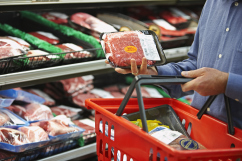
He added that the grocer, which is known for its “differentiated offer”, introduced new products in several categories focusing on British sourcing wherever possible during the first quarter.
“We have also improved our seasonal fresh offer in time for summer. For example, our by Sainsbury’s BBQ Smoked Chilli Pulled Pork and by Sainsbury’s BBQ Sweet Chilli Chicken Thighs give customers meat cuts and flavours that are perfect for the barbeque,” he said.
“Volume and transactions continue to grow as customers are benefiting from our improved value and further investments in quality. We have simplified our promotional offer, which has reduced promotional participation further, helping to lower waste and give customers even better levels of availability. We committed to deliver our cost savings programme without impacting the customer experience.
“We continue to make it easier for customers to shop with us whenever and wherever they want. We have now opened 20 grocery Click & Collect sites and remain on track to have 100 sites by the end of 2015.”
The FSA’s year-long survey, which tested around 4,000 samples of whole chickens bought from UK retail outlets and smaller independent stores and butchers over the past 12 months, found the presence of campylobacter in 73% of chickens tested. One-fifth (19%) of chickens tested positive for campylobacter with the highest band of contamination (more than 1,000 colony forming units per gram (>1,000 cfu/g)).
Just 0.1% (five samples) of packaging tested positive at the highest band of contamination with 7% of packaging testing positive for the presence of campylobacter.
All of the major retailers failed to reach industry targets to reduce the bug over the period of the study. Tesco was found to have the lowest numbers of campylobacter, with just 12.8% of its chickens found to have the highest band of contamination while 66.5% of its chickens had presence of campylobacter.
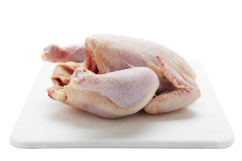
Marks & Spencer, Morrisons, Sainsbury’s and Tesco all had below-average levels of campylobacter found, while 80% of Asda chickens tested positive for its presence. Just under one-third (29.7%) of Asda chickens tested positive for the highest band of contamination.
Steve Wearne, FSA director of policy, praised the retailers that had reduced incidents of campylobacter but called for more action: “I am absolutely delighted to see the really encouraging results from these four supermarkets and their suppliers. They are making a real difference to public health, helping to cut down on the estimated 280,000 people who get ill from campylobacter each year.
“As we have always said, if you are prepared to work across the food chain to reduce the spread of this bug then you will get results.
“I want to challenge those retailers who haven’t yet demonstrated the effect that M&S, Morrisons, The Co-op and Waitrose are having on reducing campylobacter on chickens on their shelves. We expect all retailers and processors to be achieving the reductions we have seen in these retailers’ figures – that’s the only way we will meet the target we all signed up to.
“We are going to run this survey for a second year and will again look at campylobacter levels on chickens at retail sale. I hope that we will be able to see the results from the actions taken by the four retailers mentioned above and others come through and produce much lower figures for the incidence of campylobacter on the chicken we buy.”
Richard MacDonald, chair of the ACT (Acting on Campylobacter Together) board, added: “I have been impressed by the level of commitment and tangible action being taken by a number of retailers and processors of chicken. I hope we continue to see further progress in our fight to significantly reduce or even eradicate campylobacter on chickens. Individual actions and cross-industry sharing of best practice are starting to have a real and tangible impact.”
Commenting on the results, a British Poultry Council spokesperson said: “As highlighted by the FSA, individual producers and their retail customers are working bilaterally to trial options including enhanced biosecurity, management of thinning, improved processing, temperature treatments, and novel packaging. It is worth reiterating that campylobacter is killed by thorough cooking, and cross-contamination can easily be avoided by good kitchen hygiene practices.
“The BPC is committed to ensuring that when practical and effective solutions for beating campylobacter are developed, they will be made available to all producers.”
A new survey will start this summer and once again sample fresh whole chickens from all types of shops
Official figures released by the government for show UK pig slaughterings have continued to rise.
Monthly numbers were 3.4% higher for April 2015 than in April 2014 at 969,000 head. Year-on-year pigmeat production was 82,000 tonnes (t), 4.4% higher than in April 2014. Throughputs have now been up year on year for 12 consecutive months, with nearly 300,000 extra pigs processed during that period.

Once again there is little indication that the drop in pig prices is leading to producers reducing or liquidating their herds. Slaughterings in Northern Ireland were up by 4%, slightly more than in England, but figures for Scotland are not yet available. Carcase weights during the month were at their lightest since August, averaging 81.6kg, according to Defra.
Meanwhile, UK prime cattle slaughterings in February 2015 were 2.6% lower than in April 2014 at 184,000 head. Beef and veal production was 81,000t, 2.2% lower than in April 2014.
UK clean sheep slaughterings were 4.2% lower than in April 2014 at 1,058,000 head. This is the first month there has been a drop in throughput year on year since March 2014. Mutton and lamb production was 25,000t, 6.1% lower than in April 2014.
Beef prices could begin to firm up in the coming months, Quality Meat Scotland (QMS) has forecasted, in welcome news for cattle farmers, who have faced falling prices during the first part of the year.
Stuart Ashworth, head of economics services with QMS, said the supply and demand pendulum would soon start to swing back towards farmers as availability of prime cattle in the UK started to diminish in the next quarter.
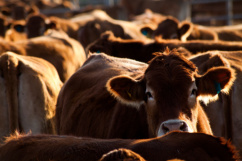
“We expect to see the volume of cattle arriving at abattoirs slow down. It is likely we will then see some firmness in the market for the beef producer,” Ashworth predicted.
Ashworth said a range of factors had led to falling prices at the start of the year, all based around supply and demand. The volume of beef produced over the first quarter increased 1%, due to cattle being slaughtered at heavier weights. In addition, the strong pound has meant imports have become attractive, and exporting has become more expensive.
“Add to that the increase in domestic supply and we find that the market has been working with around 8% more beef than a year ago,” said Ashworth.
That would not have been an issue if consumption had been strong, but while it has improved for some cuts, it has not been enough to absorb the extra supply.
“Some cuts have been selling better than others, but the product which is not selling well has been building up in processors’ chills and has had to find a market in the manufacturing trade, which has been proving sluggish,” added Ashworth.
“This explains why we have seen a slide in farm-gate prices and why some of our producers have been facing an extended period to get cattle to market.”
However, looking forward he said the outlook was looking more promising for beef farmers.
“We know from the British Cattle Movement Service (BCMS) data that the volume of cattle set to come forward as prime stock over the next six to nine months will diminish further and the same scenario is expected in Ireland,” said Ashworth. “This will mean the abattoirs will be able to manage the sale of less popular cuts out of their cold stores and the whole supply and demand balance will come closer together.”
The meat snacking market provides a substantial opportunity for businesses, according to a new report into eating habits.
The report, Redefining Healthy Snacking, found the meat snacking market has increased over 20% in several countries between 2012-2014.
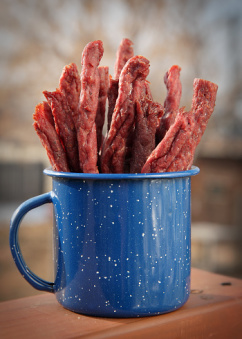
According to market analysts Neilsen, between 40% and 60% of consumers in different regions of the globe often replace a meal with a snack. The Redefining Health Snacking report found several companies are exploiting this to their advantage.
“The businesses that are proving rather successful are the ones that are creating new markets with new, differentiated snack concepts, often using new ingredients and processes, often sold under new brands (or old brands that have been boldly reinvented) with new messages,” said Julian Mellentin, author of the report. “They do not follow the market with predictable products.”
Meanwhile the report states that start-up companies are best placed to capitalise on the trend: “consumers’ beliefs about what healthy means have fragmented massively, creating a wealth of niches that can be used as platforms to build successful brands. Big companies tend to overlook areas that seem too small, leaving the way clear for entrepreneurs and start-ups.”
Food deflation continues to have an impact on meat and poultry sales according to the latest data from Kantar Worldpanel.
For the 12 weeks ending 19 March 2015, average volume sales were down, with turkey and pork experiencing the biggest decline, at -5.2% and -4.8% year-on-year respectively.
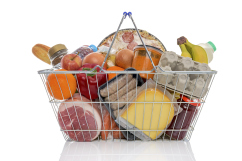
Kantar said basket size and frequency of purchase remained flat as food deflation was making the same basket cheaper.
“Fresh primary meat and poultry continues to be impacted by deflationary pressures, with the average price per kg down significantly. While this helps to drive more shoppers into the category, we are seeing basket sizes and frequency flat, as deflation makes the same basket cheaper,” Kantar Worldpanel reported.
The Office for National Statistics reported in February that food inflation had reached an all-time low at 0%, whcih remained unchanged in March.
Meanwhile a survey carried out by mySupermarket.com found that the average weekly grocery shop had fallen from £88.59, for a basket of 35 items to £87.70. The survey also found that the average weekly shop of grocery products from the main UK supermarkets had fallen 7% in the last year, with the same basket costing £93.95 in March 2014.
Meanwhile, lamb has benefited from increased Easter sales – up 14.3% on the same period last year. Kantar said price cuts and strong promotions were driving strong uplifts in sales before Easter.
Celebrity chef gets behind drive for British farming
TV chef Tom Kerridge has thrown his weight behind the National Farmers’ Union’s (NFU) campaign to back British farming and food.
Ahead of the general election, the NFU has launched the ‘Great British Food Gets my Vote’ online slogan/ campaign to ensure that domestic food and farming is part of the political debate.

Michelin-starred Kerridge wants the public to get behind the campaign and show their support. He said: “British food is incredibly important, to me personally, but also to me on a customer level. I want to be able to trace back my food to where it has come from; provenance for me is hugely important.
“For me British food has that little bit of heart and soul. The support we should give to the farmers on this small island of ours is very important. Not only is it about knowing where your food comes from, which I think leads to better quality and high standards, it will also ensure jobs.”
The NFU recently published a report on the country’s self-sufficiency, which it called “alarming”. It revealed a fall in self-sufficiency over the past 30 years to 60%, and suggested that if this continued, only half of the nation’s food would be produced on British farms in the next 25 years.
NFU deputy president Minette Batters said: “We know that food and farming is important to many people. Eighty-five per cent have told us they think supermarkets should sell more food produced on British farms and 77% think government should focus more on creating policies that help UK farmers to increase the amount of food Britain produces.
“Supporting British food and farming now will safeguard the security and availability of British food for the future. This means supporting a sector which has delivered jobs and growth during the recession and helped to create the fantastic landscapes that make up three quarters of our country.
“We are delighted that Tom has pledged his support and we would urge consumers to do the same. They can cast their vote for British food online at Vote British Food and buy British food wherever and whenever they can. And they can ask their local MP how will they back British farming?”